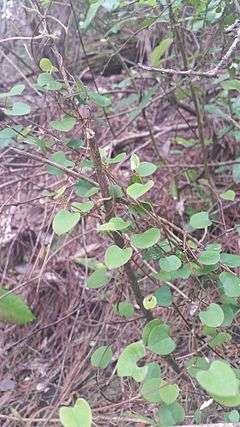Muehlenbeckia australis
| Muehlenbeckia australis | |
|---|---|
 | |
| Scientific classification | |
| Kingdom: | Plantae |
| (unranked): | Angiosperms |
| (unranked): | Eudicots |
| (unranked): | Core eudicots |
| Order: | Caryophyllales |
| Family: | Polygonaceae |
| Genus: | Muehlenbeckia |
| Species: | M. australis |
| Binomial name | |
| Muehlenbeckia australis (G.Forst.) Meisn. | |
| Synonyms[1] | |
| |
Muehlenbeckia australis, large-leaved muehlenbeckia or pohuehue, is a prostrate or climbing plant native to New Zealand.[2]
Description
The species grows up to 10 metres (33 ft) tall with grey bark. The leaves are on stiff petioles and are 25 millimetres (0.98 in) long. Lamina is 2–8 centimetres (0.79–3.15 in) by 1–3 centimetres (0.39–1.18 in) long.[1] It has juvenile and adult leaf forms and loses its leaves in winter. The flowers are greenish and the fruits are juicy with black shiny seeds covered by a white, succulent cup of sepals, which are fed on by various birds and lizards.[2] Flowers bloom from late spring to autumn, with it panicles occur usually in spring and summer.[2] Fruits are present from November to April, sometimes till June.[1]
Ecology
Muehlenbeckia australis prefers places with plenty of sunlight and climbing support, such as forest edges, cliff faces, scrub and regenerating vegetation. With its climbing and rapid growth form, it is capable of engulfing roadside trees, and has benefited from cleared habitats created since human settlement began, and is sometimes the only native species present in such areas.[2]
Muehlenbeckia australis is the host plant for the New Zealand endemic moth species Pyrgotis eudorana.[3]
References
- 1 2 3 "Muehlenbeckia australis". New Zealand Flora. Retrieved June 3, 2013.
- 1 2 3 4 "Muehlenbeckia australis (Pohuehue)". T.E.R:R.A.I.N. Retrieved June 3, 2013.
- ↑ Dugdale, J. S. (1971). "Entomology of the Aucklands and other islands South of New Zealand: lepidoptera, excluding non-Crambine Pyralidae" (PDF). Pacific Insects Monograph. 27: 72. Retrieved 16 January 2017.